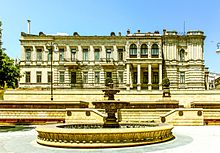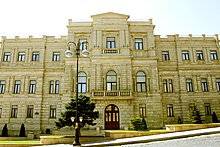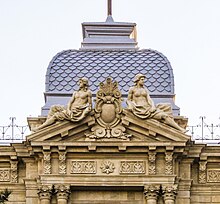National Art Museum of Azerbaijan
 De Boer's former manor: first building of the museum |
|
| Data | |
|---|---|
| place | Baku , Azerbaijan |
| architect | Nicholas of the nun |
| opening | 1936 |
| operator |
Çingiz Farzaliyev
|
| Website | |
The National Art Museum of Azerbaijan ( Azerbaijani Azərbaycan Milli İncəsənət Muzeyi ) is an art museum in the Azerbaijani capital of Baku .
The museum opened in 1936. It houses more than 17,000 exhibits (paintings, drawings, sculptures, ceramics and graphic works). In 1943 the museum was named after the set designer Rustam Mustafayev (1910–1940), one of the founders of the theater. Today the museum is located in two buildings from the end of the 19th century. The houses are connected with a glass passage.
The museum is located in the city center, southeast of the old town İçəri Şəhər , in two Wilhelminian-style buildings from 1885, designed by the German-born architect and former mayor of Baku, Nikolaus von der Nun .
History of the museum
In 1920, the Azerbaijan State Museum was created by the Department of Fine Arts. After completing the art department, and taking into account its artistic and historical value, it was decided in 1936 to create an independent museum on this basis. Originally, the performing arts department was set up in the former villa of millionaire Hajji Zeynalabdin Taghiyev , which is now the Museum of the History of Azerbaijan . The museum opened in 1937. Then the museum moved to the fifth floor of the Nisami Ganjawi Literary Museum .
In 1943, the museum received the name of the prominent Azerbaijani theater artist Rustam Mustafayev , one of the founders of the theater. Until the beginning of 1950, the collection was housed in a few historical villas, where exhibitions were also organized. During this time, young art scholars worked in the museum. B. Rasim Efendiev, Nuraddin Habibov, Mürsel Najjafov, Mehdi Huseynzade . Over the years works by People's Artists of the USSR and Azerbaijan's State Prize Winners Salam Salamzade, Kazem Kazemzade and Ibrahim Zeynalov have been added.
In 1951, the secretary of the Central Committee of the Communist Party of the Azerbaijan SSR, Mirdschafar Bagirow , handed over the building at 9 Chkalova Street (formerly Sadowaya Street, now Niyazi Street), known as "De Boer Manor", to the Art Museum. After the nobility was abolished, this building housed the office of the JSC "The Caspian Society", the Azerbaijani Revolutionary Committee and the People's Commissariat of Azerbaijan. Space for new exhibitions was created in the building. The museum was then expanded into a center for art history. Anniversary exhibitions of artists, concerts, meetings with the intelligentsia and other events were held here.
After the collapse of the Soviet Union , the government and the President of the Republic decided to use another building from 1885 for the museum, which formerly housed the "Mariinsky Girls High School" and the Baku City Council. In 1992 and 1993 it was decided to "relocate" the museum from the De Boer Palace and to establish the Ministry of Foreign Affairs of Azerbaijan in this building. According to Azad Sharif, a group of key figures in Azerbaijani culture, including Elmira Shahtakhtinskaya , Mikayil Abdullayev , Tokay Mamedov , etc., met with President Abulfaz Elchibey .
From 1994 to 2003 the sculptor Ibragim Zejnalow was director of the museum, from 2003 to 2010 Israfil Israfilow. Chingiz Farzaliev has been the director of the museum since 2010.
The opening of the new glass body of the Museum of the Arts took place on June 7, 2013. President Ilham Aliew and his wife Mehriban Aliewa attended the opening ceremony .
The buildings of the museum complex
De Boer manor house
In 1887 the manager of the "Caspian Society", Lev Martynovich de Boer, who had been living in Baku for a long time, ordered the construction of a villa for himself and his family. He bought a piece of land on Sadovaya Street at auction. He commissioned Baku's city architect, Nikolaus von der Nun , an engineer, architect and former colonel, to design and build the villa . Although there is no signature from the nuns on the plans, the project is attributed to him. On August 31, 1888, the project was officially approved and construction began. De Boer died in 1889, not long after the foundation stone was laid.
In January 1891, the land on Sadowaya Street was sold to the Caspian Society for 16,000 rubles . The company's shareholders decided to continue construction and use it as the company's administrative building. In this context, the architect had to make some changes. The building received two representative entrances and two balconies. The construction was finished in 1895.
The medallion with the letters "КТ" originally attached to the front was destroyed during repair work. SI Bagirov, the co-founder of the Caspian Society, died in 1891, and was succeeded by his son-in-law Paul Osipovich Gukasov. In 1896 the family of the company director moved into the villa.
On April 28, 1920, Baku was captured by the Red Army . Nariman Narimanov was elected chairman of the Azerbaijan Revolutionary Committee. In 1921 he was chairman of the Council of People's Commissars, which met in the former building of the Caspian Society. The Narimanovs' family lived on the second floor. After the death in 1925 Narimanovs Sadovaya Street in honor Narimanovs in was Narimanovskaya renamed.
From 1933 the first secretary of the CP of Azerbaijan, Mirdzhafar Bagirow, lived in the villa with his family. In 1930 the villa was renovated. In 1939 the street was renamed again. The villa has served as an art museum since 1951.
architecture
The villa was built in the style of historicism . The broadly laid out villa is a two-story building with nine axes , a strongly protruding surrounding cornice , two side projections and a dominant central projection , which is crowned by a triangular gable on which two allegorical figures rest.
The calm horizontal structures of the house in the following harmonized very well with the verticals of the building of the summer club and Sadichov's houses. Well-drawn classic elements, strong plastic arcades on a rustic background added to the solemn architecture of the manor house.
collection
More than 3,000 objects are exhibited in 60 museum rooms, while the entire museum stock comprises 17,000 works of art. The exhibits are changed regularly. The museum houses an important collection of Azerbaijani art, including paintings by Fuad Abdurachmanow and Sattar Bahlulzade , to which an entire hall is dedicated. The museum has an extensive collection of Azerbaijani, Russian and Western European art from the mid-16th century to the beginning of the 20th century, as well as works of art from the Orient, particularly Persian, Turkish, Chinese and Japanese art. The arts and crafts section contains hand-woven carpets from Karabakh , Gazakh , Shirvan and Absheron as well as daggers and belts traditionally decorated with precious and semi-precious stones.
Exhibits from the collection have been exhibited in Canada (1966), Cuba (1967), Syria (1968), France (1969), Czechoslovakia (1970), Algeria (1970) and Iraq (1971).
Painting collection
The museum shows u. a. Works by Il Guercino , Leandro Bassano , Francesco Solimena , Lorenzo Bartolini , Jules Dupré , Gaspard Dughet , Pascal Adolphe Dagnan-Bouveret , Jean-Joseph Benjamin-Constant , Frans Hals , Michiel Jansz van Mierevelt , Adriaen Brouwer , Adriaen van Ostade , Justus Sustermans , Pieter Claesz , Johann Heinrich Roos , Friedrich August von Kaulbach and Jan Styka painter. The collection includes works by Russian artist Karl Bryullov , Alexey Venetsianov , Vasily Vasilyevich Vereshchagin , Isaac Ilich Levitan , Vladimir Jegorowitsch Makowski , Valentin Serov , Vladimir Borovikovsky , Vasily Tropinin , Konstantin Korovin and Ivan Ivanovich Shishkin .
Ancient and Medieval Art
The Azerbaijan Ancient and Medieval Art Department includes a wide variety of objects found in the Azerbaijan territory, including figures of birds from Nakhchivan of the Manna era , female figures from the 3rd to 1st centuries BC. From Baku and Şəki , human figures from the 1st to 3rd centuries BC BC, which were found during excavations in the settlement of Hynysly in Şamaxı , ceramics from Gəncə , Beyləqan , Qəbələ , Mingechaur, a stone slab with relief, inscriptions and images of the Sabayel Castle and various tombstones in the form of horses.
Azerbaijani art of the modern age
The collection includes works by Usta Ganbar Karabaghi and other unknown artists of the 18th century. In addition to early works from the 19th century, works by representatives of Azerbaijani realistic art ( Mirza Kadim Erivani , Mir Mohsun Navvab , B. Kangarli A. Azimzade) are shown.
The collection of 20th century Azerbaijani painting includes works by Salam Salamzade, Mikail Abdullayev, Amira Gadzhieva, Tagi Tagiyev, Togrul Narimanbeyov, Tahir Salahov, Vidadi Narimanbeyov and Gazanfar Halykova. A separate room is dedicated to the painters Sattar Bahlulzade, Tahir Salahov and the sculptor Omar Eldarov.
Web links
- The Azerbaijan State Museum of Art , information on Bakupages.com
Individual evidence
- ↑ Интервью директора музея Чингиза Фарзалиева. Наша коллекция насчитывает свыше 17 тысяч экспонатов // газета: «Азербайджанские известия». - 2 марта 2012. (Russian)
- ↑ a b History of the Museum (English)
- ↑ Мустафаев Рустам Мамед оглы. Retrieved March 10, 2017 .
- ↑ a b N. A. Ragimowa: Научно-исследовательская работа в музее на основе фондов: на примере. Азербаймере Азербаймере Азеркого. Р. Мустафаева ( Memento of the original from February 24, 2015 in the Internet Archive ) Info: The archive link was inserted automatically and has not yet been checked. Please check the original and archive link according to the instructions and then remove this notice. , 2010
- ↑ a b Под ред. Дж. Б. Кулиева (Ed.): Азәрбајҹан инҹәсәнәт музеји . tape 1 . Главная редакция АСЭ, Азербайджанская Советская Энциклопедия 1976, p. 144 .
- ↑ a b Ibrahim Zeynalov: Breathing Life Back Into Art. The National Art Museum , Azerbaijan International 8.2 / 2000, pp. 48-50
- ↑ a b c Шамиль Фатуллаев .: Градостроительство Баку XIX— начала XX веков . Ed .: Под ред. проф. В. И. Пилявского. Стройиздат , Ленинград 1978, p. 215 ( narod.ru ).
- ↑ a b c d e Тамара Гумбатова .: Дебуровский дворец. In: Проза.ру. литературный портал, 2012, accessed March 10, 2017 .
- ↑ İbrahim İsmayıl oğlu Zeynalov. Azərbaycan, March 7, 2008, p. 4 , accessed March 10, 2017 (Azerbaijani).
- ↑ Ильхам Алиев принял участие в церемонии открытия нового корпуса Азербайджанского националь .зкого националь
- ↑ Н. А. Рагимова .: [Научно-исследовательская работа в музее на основе фондов: на примере Азербаймаре. Азербаймаре. Азербаймаре. Азербаймаре. Р. Мустафаева. http://history.spbu.ru/userfiles/VM_Ragimova.pdf ] . In: Вопросы музеологии . журнал. 2010.
- ↑ a b Р. М. Эфендизаде .: Проспект Нариманова - принципы архитектурно-планировочного решения . Издательство Академии наук Азербайджанской ССР. 1980.
- ↑ Ибрагим Зейналов, бывший директор музея .: Breathing Life Back Into Art. The National Art Museum . Magazine. Pp. 48-50. 2000.
- ↑ Böyük Sovet Ensiklopediyasından Azərbaycan İncəsənət Muzeyi ( Memento of the original from August 22, 2011 in the Internet Archive ) Info: The archive link was automatically inserted and not yet checked. Please check the original and archive link according to the instructions and then remove this notice. məqaləsi
Coordinates: 40 ° 21 ′ 47 " N , 49 ° 49 ′ 54" E




